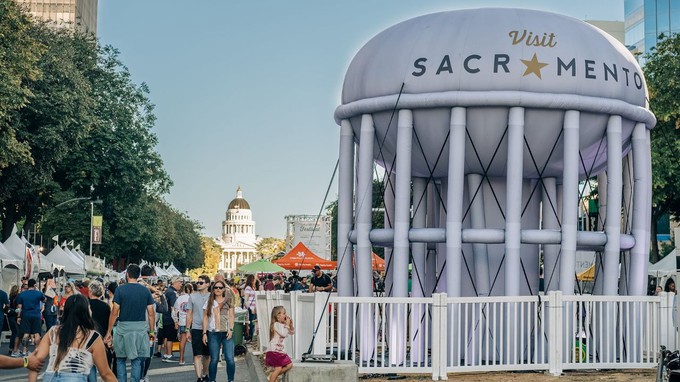
Three blocks of food, beverage, music and agricultural inspiration highlight this free event

People admire the inflatable version of Sacramento's iconic water tower on the Capitol Mall during the Farm-to-Fork Street Festival. Photo courtesy of Visit Sacramento VisitSacramento.com
Time to ring some cowbells! It’s Farm-to-Fork Week in the Farm-to-Fork Capital.
Highlighting festivities will be the Farm-to-Fork Street Festival, set for Friday and Saturday, Sept 23 and 24, on the Capitol Mall.
Hundreds of vendors and agriculturally related organizations will pack Capitol Mall from Fourth to Seventh streets in downtown Sacramento. Admission is free.
Catch the flavor of Sacramento (and neighboring farm communities, too) during what amounts to a three blocks-long tasting party. Wine, beer and cider tasting will be offered; cocktails will be available, too. This is a cashless event; bring credit or debit cards.
SacRT will offer free rides to and from the festival with an official flier, available here:
https://www.farmtofork.com/wp-content/uploads/FarmtoForkFestival-FreeRideFlyer-2022.pdf
Free bike valet parking is available Saturday. Otherwise, patrons can use street parking.
Begun in 2013, the Farm-to-Fork Street Festival attracted a record 155,000 patrons over two days in 2019. After a COVID hiatus, a scaled-back street festival returned in 2021 with pandemic precautions (including proof of vaccination or negative test).
“This year, the full festival is back, with three demonstration stages about food, including one hosted by the James Beard Foundation to showcase culinary talent,” says Visit Sacramento, the festival’s organizer. “More seating will be available around the bars on Fourth and Fifth streets and Capitol Mall this year thanks to IKEA, and there will be a hyperlocal bar on Seventh Street and Capitol Mall with a different selection than the other two, so be sure to explore the entire length of the festival, enjoying for-purchase drinks from Bogle Wine, Lucid Winery, JJ Pfister, Hangar One Vodka and more. Also being poured at the festival this year is wine from Vino Noceto, which won the People's Choice Award at Legends of Wine this year.”
Accompanying the food and drink will be a full line-up of music topped by Grammy-winning jazz vocalist Gregory Porter on Friday and alt-pop band Japanese Breakfast on Saturday.
Also entertaining (and informing) the crowd will a series of cooking demonstrations. Learn how to make Slow Food fast, create hand-pulled noodles and discover your food heritage.
Hours are 4 to 9 p.m Friday and 11 a.m. to 9 p.m. Saturday. Find a full list of demonstrations, vendors, concert line-up and more: https://www.farmtofork.com/events/street-festival/.
Comments
0 comments have been posted.Sacramento Digs Gardening to your inbox.
Sites We Like
Garden Checklist for week of July 21
Your garden needs you!
* Keep your vegetable garden watered, mulched and weeded. Water before 8 a.m. to reduce the chance of fungal infection and to conserve moisture.
* Feed vegetable plants bone meal, rock phosphate or other fertilizers high in phosphate to stimulate more blooms and fruiting. (But wait until daily high temperatures drop out of the 100s.)
* Don’t let tomatoes wilt or dry out completely. Give tomatoes a deep watering two to three times a week.
* Harvest vegetables promptly to encourage plants to produce more. Squash especially tends to grow rapidly in hot weather. Keep an eye on zucchini.
* Pinch back chrysanthemums for bushy plants and more flowers in September.
* Remove spent flowers from roses, daylilies and other bloomers as they finish flowering.
* Pinch off blooms from basil so the plant will grow more leaves.
* Cut back lavender after flowering to promote a second bloom.
* It's not too late to add a splash of color. Plant petunias, snapdragons, zinnias and marigolds.
* From seed, plant corn, pumpkins, radishes, winter squash and sunflowers.